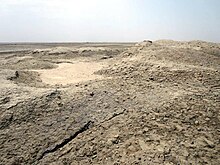Tell al-'Ubaid
Archaeological site in Iraq From Wikipedia, the free encyclopedia
Archaeological site in Iraq From Wikipedia, the free encyclopedia
Tell al-'Ubaid (Arabic: العبيد) is a low, relatively small tell (settlement mound) west of nearby Ur in southern Iraq's Dhi Qar Governorate. Most of the remains are from the Chalcolithic Ubaid period, for which Tell al-'Ubaid is the type site, with an Early Dynastic temple and cemetery at the highest point. It was a cult center for the goddess Ninhursag.[1]
العبيد | |
 | |
| Location | Dhi Qar Governorate, Iraq |
|---|---|
| Region | Lower Mesopotamia |
| Coordinates | 30°58′12″N 46°1′32″E |
| Type | tell, type site |
| Length | 350 metre |
| Width | 250 metre |
| Height | 2 metre |
| History | |
| Periods | Early Dynastic period, Ubaid period, Jemdet Nasr period, Ur III period |
| Site notes | |
| Excavation dates | 1919; 1923; 1924; 1937 |
| Archaeologists | Henry Hall, Leonard Woolley, Pinhas Pierre Delougaz, Seton Lloyd |
The site was first worked by Henry Hall of the British Museum in 1919.[2] He found an Early Dynastic III stone statue of Kurlil.[3] Later, C. L. Woolley excavated there in 1923 and 1924,[4] followed by Seton Lloyd and Pinhas Delougaz in 1937, the latter working for the Oriental Institute of the University of Chicago.[5][6]
Today, Tell al-'Ubaid lies 250 kilometres (160 mi) from the Persian Gulf, but the shoreline lay much closer to the site during the Ubaid period. The tell, or settlement mound, is an oblong measuring approximately 500 by 300 metres (1,640 ft × 980 ft) on a roughly north-south axis. It extends about 2 metres (6 ft 7 in) above the current surface. The excavated Early Dynastic temple of Ninḫursaĝ, A-Ane-pada, is located on the northern edge of the site. Finds included a copper framed frieze of limestone birds set in a black shale background.[7] The temple was also worked on in the Ur III period.[8][9] A cemetery was also found with 96 graves, mostly from the Early Dynastic Period.[10]
The lower level of the site featured large amounts of Ubaid pottery and associated kilns. Evidence for Ubaid period pottery manufacture has also been observed on the surface of the site. The size of the surface scatter indicates that pottery production was a specialized craft, and this confirms finds from other Ubaid sites like Eridu.[8] The site also yielded a cemetery and some finds from the Jemdet Nasr period. The temple of Ninhursag at the summit was on a cleared oval similar to that at Khafajah. The wall surrounding the temple was built by Shulgi of the Ur III Empire.
Seamless Wikipedia browsing. On steroids.
Every time you click a link to Wikipedia, Wiktionary or Wikiquote in your browser's search results, it will show the modern Wikiwand interface.
Wikiwand extension is a five stars, simple, with minimum permission required to keep your browsing private, safe and transparent.